PRE2025 1 Group1
| Name | Student number | Study | |
|---|---|---|---|
| Robert Arnhold | 1847848 | Mechanical Engineering | r.w.arnhold@student.tue.nl |
| Sietse Bosman | 1894013 | Applied Physics | s.bosman@student.tue.nl |
| Octavian Astefanei | 1836374 | Electrical Engineering | o.astefanei@student.tue.nl |
| Anne Willems | 1631810 | Electrical Engineering | a.m.j.e.willems@student.tue.nl |
| Kerim Gjergjizi | 1813420 | Electrical Engineering | k.gjergjizi@student.tue.nl |
| Lucas Spronk | 1563564 | Computer Science | l.spronk@student.tue.nl |
Plan
Concept Introduction
This project aims to design and prototype a smart hamster cage. Hamster cages have long featured similar designs, features and limitations. While a hamster wheel may give the hamster the ability to exercise, a water bottle give it the ability to drink and a food bowl the ability to eat, these are all parts of the hamster cage that are long outdated. In our modern world there is a market gap: a hamster cage that can help care for your hamster, teach you more about it, and let you better interact with your beloved pet. If successful, this proof-of-concept opens the door to an expansion towards larger pet enclosures such as rabbits, guinea pigs, and more.
Objectives
- Provide reliable care for the hamster, even while users are away
- Help users more effectively care for their hamsters
- Other, user-defined objectives that will be found via user research
Users
General Target Audience:
The target audience consist of hamster owners themselves, as well as anyone else involved in caring for the hamster, e.g. owner's family or roommates.
People of various ages own hamsters, but they are mostly "millennials, aged 25-39", who "make up about one in three small-pet owners" (also includes fish, birds and some other animals) [1]. There is a strong correlation with younger aged owners, especially the presence of household members under the age of 12; "approximately 72% of hamster owns are under the age of 44" [2], and "nearly 90% of households with hamsters include children, and 87% of those households have children under 12 years old" [3].
While small-pet owners in the U.S. tend to earn lower incomes than other pet owners [2], they actually spend more on their animals. On average, small-pet households spend about 252 USD/month, compared to 140 USD for dog owners. Spending patterns also vary by demographics: men spend slightly more than women, married owners spend slightly more than singles, and younger owners (18–24) spend the most overall (174USD/month), with pet spending declining gradually with age [4]. The exception to this spending trend is the age group of 14-17 with the lowest average spending of 73USD/month [4]. While there is a general willingness to spend upwards of 100USD on small pets every month, this also highlights the need to keep costs manageable for younger owners with limited budgets.
Finally, owners of small pets are most commonly "urban dwellers, particularly those [living] in apartments or smaller living spaces". They "disproportionately own compact pets due to space constraints" [5], and since hamsters are quite restricted in their spacial requirements compared to other larger animals or animals with special living conditions, hamsters are very popular in this demographic category. The majority of families with children live in suburban single-family homes with more space, however the smart hamster cage should not significantly exceed the dimensions of a regular cage to ensure product suitability for those living in more compact environments such as apartments and student housing.
To conclude, a preliminary target market can be narrowed down to users between 12 and 44 years old, typically either children or their parents, who either care for the hamster themselves or live with family who helps take care of the pet. Users will typically be willing to spend upwards of 73 to 137USD/month, which suggests a further increased price range for a one-time purchase.
Example User Profiles:
Emma, 12 years old (student)
- Recently got her first hamster as a pet.
- Parents want her to learn responsibility but also want to ensure pet safety.
- Would benefit from automated feeding/water alerts and activity data.
- Likes fun graphics showing hamster’s daily life.
Michael, 28 years old (busy professional)
- Works long hours and sometimes travels for a few days.
- Wants peace of mind that his hamster has food/water when away.
- Needs reliable notifications and refill reminders.
- Less interested in visuals, more in core “care assurance” features.
Sofia, 38 years old (parent of two children)
- Sarah has two children, ages 7 and 10.
- Children are responsible for daily care but Sarah supervises to ensure the hamster’s well-being.
- Values tools that make pet care educational and fun.
- Wants quick access to reliable information to monitor the hamster throughout the day.
State-of-the-Art
A low-cost automated apparatus for investigating the effects of social defeat in Syrian hamsters [7]
Relevant points/summary:
The article is about an automated apparatus that can used to investigate the effects of defeat in hamsters. They use low power lasers and laser detectors to keep track of the position of the master. A computer measures three things using the lasers\detectors: average position, frequency of visits to each chamberand the duration of these visits, and the frequency of changes in direction of travel in each chamber. The data collection program they use is MEDPC for windows.
An Open-Source, Automated Home-Cage Sipper Device for Monitoring Liquid Ingestive Behavior in Rodents [8]
Relevant points/summary:
Common approaches for measuring liquid intake:
- Computer-tethered lickometers
- Video based systems
- Measuring or weighing the liquid
In the article they made a photobeam-based sipper device.
Advantages:
- battery powered (battery life of > 2 weeks)
- fits in vivarium caging
- quantifies the intake of two different liquids simultaneously
- low cost and easily constructed
- provides data with high temporal resolution (allows for detailed analysis of drinking patterns)
- open source
Disadvantage
- Animal interactions that are picked up by the sensor are not limited to licks
In the article they use the device to measure the volume of liquid ingested, whether there is a preference for chocolate milk vs water and confirm that the sipper device can be succesfuly integrated with in vivo measurements.
A System for Monitoring Animals Based on Behavioral Information and Internal State Information [6]
Relevant points/summary:
In this paper, a monitoring system for animals using video image analysis is used. It extracts features related to behavorial information and the animal internal state via mask R-CNN. These features are used to detect typical daily activities and anomalous activities. This way it can detected when the hamster behaves in an unusual way. The system also combines a new feature extraction method using deep neural network techology and an anomaly detection method.
The systems consists of 4 parts:
- Signal measurement: a digital hi-vision video camera
- Feature extraction: mask R-CNN and color information detection
- State discrimination: one class SVM
- Display: PC with an HDMI capture device
To test the system a loud sound was generated and the hamsters reaction was measured.
The discrimination rate of non-daily activities did not have a high level of accuracy. Mainly because the hamster shrank during the daily activities and the direction vector was often inverted because of the noise caused by the hamster’s shadow. The training data also includes infrequent situations in daily activities, which makes it possible that the discriminative boundary was not accurately determined
Design and Development of a Smart Pet Feeder with IoT and Deep Learning [9]
Relevant points/summary:
Automatic pet feeder was developed using internet of things technolgy and deep learning to address feeding challenges. The system makes sure the pet receives the right amount of food, regardless of whether the owner is available. This makes sure the animal stays healthy, because an owners busy schedule can often lead to inconsistent feeding, which can cause malnutrition or obesity. It is also offers pet owners convenience and peace of mind by enabling the feeding process in their absence.
The system architecture:
- Weight sensor (Tecneu HX711): determines pets weight and food weight
- Camera: detects which species
- Ultrasonic sensor (HC-SR04): measures distance to the pet from the feeder.
- Servo motor: controls dispensing mechanism
- Arduino (mega 2560): microcontroller that handles all the actuators and sensors.
Areas of improvement that were mentioned:
The system could learn from a pets’ eating patterns and adjust feeding schedules and portion sizes over time and adding other pet identification, since only dogs were used to train this system.
A Novel Automated System Yields Reproducible Temporal Feeding Patterns in Laboratory Rodents [10]
Relevant points/summary:
In this article the aims was to develop and validate a reliable method for supplying crushed diets to laboratory rodents in consistent, relevant feeding patterns for prolonged periods.
They used 2 different feeding patterns:
-nocturnal meal-feeding
-nocturnal grazing
The cumulative food intake for both methods was the same.
PiE: an open-source pipeline for home cage behavioral analysis [11]
Relevant points/summary:
In this article PiE is introduced, an open-source, end-to-end, user configurable, scalable, and inexpensive behavior assay system. It has a custom-built behavior box to hold a home cage, as well as software enabling continuous video recording and individual behavior box environmental control. The PiE system reduces environmental and experimenter disruptions by providing fully remote control and monitoring of home cage behaviors. The system was tested on mice. The sensors and actuators that were used were a ceiling mounted, downward facing, infrared (IR) video camera (Pi NoIR) to allow both daytime and nighttime video recording, (2) white and IR LEDs to illuminate the behavior box (Note: to match the Pi NoIR camera sensor, 940nm or shorter wavelength IR LEDs are preferred for optimal nighttime illumination), (3) a temperature and humidity sensor, and (4) a circulating fan for climate stability, which were controlled by a raspberry pi. Desktop software, called VideoAnnotate, was used to perform behavioral analysis.
CageView: A Smart Food Control and Monitoring System for Phenotypical Research In Vivo [12]
Relevant points/summary:
The article introduces an automated and smart system (named CageView) used to monitor a mouse, detect motion, and control access to food in accordance with experimental schedules. Cageview accomplishes it food control and activity monitoring via:
1. An actuator for linear displacements of the food access door controlled by a custom-designed interface to set the feeding and fasting schedule;
2. A vision unit with visible and near-infrared cameras and a near mid-infrared LED for day and nighttime monitoring, which forms a video streaming and data transmission system using wireless or wired communication networks; It also uses a a Raspberry Pi single-board computer.
3. A trained convolutional neural network (CNN) that detects the animal position in the image which enables movement measurement.
The feeding mechanism is designed to be mounted on conventional cages used in most research centers and has a sliding mechanism that can enable or disable the animal’s access to food. Activity measurement is done via making an activity heatmap and distance measurement.
The CageView technology has been disclosed in the Maddahi Y. and Maddahi A. Methods and apparatus for monitoring, feeding, and checking animals. United States Patent. US 63/321,368, 2022
Feeding Experimentation Device (FED): Construction and Validation of an Open-source Device for Measuring Food Intake in Rodents [13]
Relevant points/summary:
In the article they provide a description of a solution for measuring food intake by mice, FED. FED is an open-source system that was designed to facilitate flexibility in food intake studies. It is compact and battery powered so it can fit in standard home cages. The mice are fed using food pellets. When a mouse removes a pellet, a photointerrupter sensor sends a signal to the microcontroller and the time-stamp is logged on the onboard secure digital (SD) card. A new pellet is dispensed via the motor. The feeding can be limited to specific times of the day. The limitations of the FED:
- SD card can be a cumbersome means to track and store data from many FEDs
- Pellet jams could occur
- Users should never leave mice with FED as their only food source without checking FED's functionality daily
A single FED can be assembled for approximately $350.
An open source automatic feeder for animal experiments [14]
Relevant points/summary:
In the article they describe an open source experimental feeder using an Arduino microcontroller. This feeder can be used for most sizes of dry food pellets with the potential modification of a single component; They also describe the buidling procedure of the feeder. They tested it on pigeons, monkeys and cats. The cost for building this feeder is less than 200 euros.
The Promise of Automated Home-Cage Monitoring in Improving Translational Utility of Psychiatric Research in Rodents [15]
Relevant points/summary:
In the article they describe three of the most commonly used approaches for automated home cage monitoring in rodents and review several commercially available systems that integrate the different approaches. Automated home-cage monitoring records rodent behavior in their home cage over extended periods using minimal human contact.
Approaches:
- Operant wall systems: detect nose pokes using an infrared beam and deliver food pellets or liquid in response to learned behaviors. Behaviors are directed by light or tone cues controlled by the operant wall.
- computerized visual systems: CVS monitor behavior at high temporal resolution over extended periods including the dark and light phases of the circadian cycle, and trainable software are publicly available. The trainable nature of CVS allows for extensive flexibility in terms of the behavioral phenotypes it monitors. Limitations of the CVS include the requirement for adequate contrast between the rodent and its background and the need for most systems to house animals individually
- Automatic motion sensors: use motion sensors to assess locomotor activity. AMS generate data about distance traveled, velocity, and time spent at specific locations within the cage. They are unobtrusive and are not affected by lighting conditions, allowing for reliable data collection during the dark cycle on locomotor activity and sleep behavior
LocoBox: Modular Hardware and Open-Source Software for Circadian Entrainment and Behavioral Monitoring in Home Cages [16]
This article introduces LocoBox, an affordable, open-source system combining hardware and software to control light–dark cycles and monitor locomotor activity in home cages—ideal for circadian rhythm research. LocoBox empowers circadian researchers with a flexible, scalable, and budget-friendly tool. It allows for custom entrainment experiments and long-term behavioral monitoring—all using open-source solutions that can be easily adopted or adapted.
Key Features
- Hardware: Each LocoBox is a light-sealed Plexiglas enclosure equipped with:
- An LED (with heat sink and diffuser) for programmable lighting
- A passive infrared (PIR) sensor for detecting animal movement
- A silent ventilation fan and real-time clock (RTC)
- Managed by an Arduino Mega 2560 and daisy-chained power design for easy scalability.
- Software:
- Arduino-based firmware ensures accurate timing and control of light phases.
- Python GUI (using Tkinter and pySerial) allows users to define up to 12 sequential lighting “phases”, including flexible T-cycles (non-24-hour cycles), simulate jet lag, seasonal variations, etc. — and replicate schedules across up to five boxes per controller.
- Data Logging & Visualization:
- Activity and light state are logged every minute in TSV format.
- Built-in tools enable generation of double-plot actograms and spectral heatmaps to visualize power spectral density and phase angles over time.
- Accessibility & Scalability:
- Replicable with common, low-cost components (~USD 100–150 per box).
- Entire system (hardware blueprints, Arduino and Python code) is freely available on GitHub.
- Suitable for long-term and parallel experiments, democratizing circadian research even in resource-limited labs.
Automated Home Cage Monitoring of an Aging Colony of Mice—Implications for Welfare Monitoring and Experimentation [17]
Overview
This study leverages Home Cage Monitoring (HCM) using a Digitally Ventilated Cage (DVC) system to track activity patterns and rest disturbance indices (RDI) in an aging colony of male and female C57BL/6 mice, offering insights relevant to both welfare and experimental design Frontiers. This research demonstrates the value of high-resolution, long-term automated monitoring of mice. It reveals dynamic changes in activity and rest behavior with age, responses to cage handling, and capability to flag welfare-related behaviors—underscoring HCM’s promise for humane, data-rich research.
Generally not that interesting on the hardware side, as it is too different from what we want to use. Instead this article can be used for reference for psychological and behavioural data collection and processing.
Methods
- Mice were housed in DVC systems and monitored longitudinally up to 18 months of age.
- Used statistical models (linear mixed models) to assess habituation, aging, and effects of cage changes.
- Stereotypic behaviors were identified through visual inspection of activity spikes Frontiers.
Key Findings
- Upon arrival, mice showed high activity and RDI during the light phase and reduced activity during the dark phase, normalizing to typical circadian behavior after several days.
- Age-related changes: Activity decreased from 5 to 14 months, then rebounded toward baseline levels.
- Stereotypy detection: Cages flagged for stereotypic behavior exhibited sustained activity spikes, especially pronounced during the dark phase.
- Cage changes caused increased activity and RDI during the light phase, but did not significantly affect the dark phase—this pattern was consistent over time across ages Frontiers.
Implications
The findings:
- Illustrate how HCM can detect distinct behavioral changes across aging stages.
- Highlight the potential of automated monitoring systems like DVC to detect early welfare concerns (e.g. stereotypic behavior).
- Support the use of HCM for improving experimental rigor and animal welfare in long-term studies Frontiers.
Rodent Behavioral Assessment in the Home Cage Using the SmartCage System [18]
This system termed SmartCage measures rodents’ behavior in their home cages as a significant endpoint. The SmartCage system consists of multiple instrument platforms that interface with ordinary rodent home cages. Each SmartCage is comprised of multiple sensors including a floor-vibration sensor, an infrared (IR) matrix and flexible modular devices. This system is noninvasive and allows the animal to be tested in its home cage that has bedding, food, and water, making it appropriate to monitor animals for days or weeks. The automated measurements include wake and sleep/inactive states. The active parameters include locomotion, rearing, and animal movement patterns, for example, rotations (cycling).
A System for Monitoring Animals Based on Behavioral Information and Internal State Information [19]
In the current study, a system is proposed that discriminates the state of an animal by combining two types of features: behavioral information, which determines the kind of movement performed by the animal, and internal information, which reflects the animal’s internal state. The proposed system measures biological information from camera images and extracts features to discriminate states using machine learning. In addition, a neural network was used to increase the accuracy of detecting the target, and an anomaly detection method was used to perform discrimination. In the experiments performed, video images were prepared that contain routine behaviors and generated a model that can detect non-routine behaviors using the proposed system. We also prepared video images including non-routine behavior in which the hamster was stimulated by clapping to generate an abnormal sound. In the video, the behavior changed significantly before and after the stimulus presentation, and the extracted feature values also changed according to the behavior. As a result of detection, the system discriminated the behavior as non-routine behavior after the stimulation. In conclusion, the results supported the possibility of using a pet monitoring system to immediately inform the owner when the animal is under load.
The Promise of Automated Home-Cage Monitoring in Improving Translational Utility of Psychiatric Research in Rodents [20]
Type & Scope: Mini-review highlighting the potential of automated home-cage monitoring (AHCM) for psychiatric research.
Key Points:
- Problem addressed: Traditional behavioral tests for psychiatric phenotypes often rely on brief sessions (<10 min), are sensitive to environmental and experimenter-related factors, and yield poor reproducibility and translational reliability.
- Solution proposed: AHCM enables continuous, minimally intrusive monitoring within the home cage, generating large datasets that span circadian and estrous cycles, reduce human influence, and increase sensitivity to behavioral changes.
- Approaches reviewed:
- Operant Wall Systems (OWS) – Sensors for nose pokes that deliver rewards; suitable for tasks such as timing and working memory.
- Computerized Visual Systems (CVS) – Video-based tracking for locomotion and exploration.
- Automatic Motion Sensors (AMS) – Infrared or motion detection to capture activity levels.
- Commercial platforms such as IntelliCage, PhenoTyper, Actual-HCA, and Chora Feeder integrate these methods for group- or individual-housed rodents.
- Advantages: Better reproducibility, high temporal resolution, social-context cued behavior tracking, and improved translational validity.
- Conclusion: AHCM offers a more robust alternative to brief traditional tests, with recommendations to integrate, validate, and expand use of these systems in pre-clinical psychiatric research.
Comparison of automated home-cage monitoring systems: emphasis on feeding behaviour, activity and spatial learning following pharmacological interventions [21]
Relevant points/summary:
This study assessed the effectiveness of three different observation systems as methods for determining strain and pharmacological induced differences in locomotor activity, feeding behaviour and spatial learning.
The test subjects in this study were mice.
Observation systems that were used:
- PhenoTyper: utilises video-observation to record movement of individual subjects. In the test they measured the total distance moved in hourly bins following drug treatment and the time spent in the food zone
- PhenoMaster: relies on infrared sensors for the detection of horizontal and vertical activity. In the test they measured the food consumption and the total distance moved in hourly bins prior to and for the 12 h following drug treatment. It has weight transducers, for food and water measurement.
- IntelliCage: does the monitoring and registration of activity of micro-chipped animals via antenna-containing tubes for entry into activity corners. In the test they measured the number of visits to rewarded corner in hourly bins prior to and following drug treatment and the total number of visits to all corners.
The benefit of using different home-cage observation systems is that in addition to assessing exploratory activity by way of different tracking parameters each system has distinctive recording features which could be used to complement one another and facilitate characterization of mice and pharmacological induced changes.
Development of Eight Wireless Automated Cages System with Two Lickometers Each for Rodents [22]
Relevant points/summary: In this article they present a low-cost alternative for a lickometer system that allows wireless data acquisition of licks from eight cages with two sippers each.
They present three development and validation steps:
All prototypes consisted of an Arduino MEGA, used for the analog/digital conversion (A/D converter) of the sensor’s signal, a Secure Digital (SD) card module to store the data, a realtime clock module (DS3231) to precisely time the licks events and a Liquid Crystal Display (LCD) 16 x 2 to show the number of licks and date/time of occurrence.
Prototypes:
1. light dependent resistor (LDR): was discarded, did not have adequate stability because of environmental luminosity.
2. photo electric: precision was 77.02 6 11.69%
3. capacitive (touch): precision was 91.14 6 5%
The prototypes did not statistically differ, the capacitive prototype was chosen.
- translation to wireless transmission and validation with emulated signals
The in silico validation step with simulated licks at extreme and typical rates was proposed. It is important to verify whether other wireless equipment is turned off to avoid loss of information.
- in vivo validation using mice drinking in two-bottle lickometer cages.
Limitations to system:
- The device does not measure volume
- manufacturing the lickometer and installing the software requires knowledge beyond behavioral neuroscience
My friend MIROSLAV: A hackable open-source hardware and software platform for high-throughput monitoring of rodent activity in the home cage [23]
MIROSLAV (Multicage InfraRed Open-Source Locomotor Activity eValuator) is an Arduino-based tool for continuous, non-invasive monitoring of rodent activity in their home cages.
MIROSLAV's key features include, but are not limited to:
- Easily customized for different environments and experiment needs
- Minimizes data loss and reduces disturbance to animals
- Includes modules for data preparation (Prepare-a-SLAV), cleaning (TidySLAV), exploratory analysis (MIROSine – MIRO The Explorer), and statistical analysis of circadian rhythms (MIROSine – StatistiSLAV).
Applied in a rat model of sporadic Alzheimer’s disease, MIROSLAV detected circadian disruptions and altered responses to routine stimuli like bedding changes.
In short, MIROSLAV is a flexible, open-source system designed to aid long-term behavioral and circadian monitoring in rodents, with minimal intrusion, robust data collection, and a complete analysis workflow.
Approach
General Approach
Our approach to developing a smarter hamster cage is guided by three main principles: scientific validity, user-centered design, and technological feasibility. From the beginning, the team decided that the hamster’s welfare had to be the main factor in shaping our technical choices. This required us to draw extensively on literature in animal monitoring and feeding technologies, most of which originated from laboratory rodent studies. For example, automated home-cage monitoring systems have been shown to improve the reproduction and animal welfare by allowing for continuous, minimally intrusive observations of rodents in their natural living environment [15][20]. Similarly, systems such as SmartCage demonstrate the feasibility of integrating multiple sensors to track locomotion, rearing, and even circadian activity rhythms in real time, all while leaving the animals relatively undisturbed in their enclosure [18]. These insights inspired our vision of a cage that actively monitors hamster behavior and health and automates their food consumption, without introducing stress or altering its natural routines.
Equally important is the owner’s perspective. While much of the existing research on automated feeding and monitoring technologies come from laboratory rodent studies [8][13][15]][20], our project acknowledges that the priorities of pet owners might be different. To capture these needs, we plan to conduct interviews and distribute questionnaires among hamster and other rodent owners. This will provide a deeper look into personal concerns of home-owners such as convenience, cost, emotional engagement, and educational value for children. We expect these findings to reshape our design towards features that are most meaningful for households.
Potential Features
The technical features we propose are not isolated add-ons but part of a coherent monitoring and care ecosystem. A central element is an automated feeding system. Inspired by devices such as the Feeding Experimentation Device (FED) [13] and CageView [12], our prototype will employ a microcontroller-driven feeder with integrated weight sensors to dispense precise amounts of food. Unlike laboratory feeders, however, our design should emphasize reliability for everyday pet use and safeguards against malfunctions, since in a domestic context there is no research technician on hand to intervene.
Behavioral monitoring is another cornerstone. Systems based on computer vision and deep learning, such as the one described by Shibanoki et al. [6][19], show the potential of detecting unusual or stress-related behaviors by analyzing posture and activity patterns. While a fully AI-driven vision system may exceed the scope of our prototype, simplified methods such as passive infrared sensors, wheel encoders, or low-light cameras can still generate valuable activity profiles.
Environmental monitoring is the third axis of our approach. Inspired by research on home-cage monitoring of aging mice [17], which showed that changes in activity and rest patterns can flag welfare concerns, we plan to integrate basic climate sensors (temperature and humidity) and ammonia detection. This ensures that cleaning and ventilation are triggered by real welfare indicators rather than arbitrary schedules, aligning with best practices in laboratory husbandry.
Together, these systems form a smart cage concept. The hamster’s physical needs are reliably met, its behavior is continuously tracked, and the owner receives actionable information through an app interface.
Expected Outcomes
By following this staged and evidence-based approach, the project will deliver a prototype that not only demonstrates technological novelty but also addresses concrete welfare concerns in hamster care. Integrating insights from open-source monitoring systems [11][16], smart feeding devices [9][13], and automated welfare detection [6][19][20], we expect our design to serve as a model for future smart pet enclosures.
Planning
| Week 1 | Week 2 | Week 3 | Week 4 | Week 5 | Week 6 | Week 7 | Week 8 |
|---|---|---|---|---|---|---|---|
| Course introduction and formation of the team | Research on the selected topic | Interview possible users | Interview possible users | Work on and test
the prototype |
Work on and test
the prototype |
Finish the prototype
and do final testing |
Finish wiki |
| Brainstorming and deciding the project idea | Create interview questions for
possible interested people |
Update the wiki page with
the data gathered from the interviews |
Decide additional characteristics
based on the interviews |
Research | Research | Work on the presentation
and demo |
Final presentation
and demo |
| Research on the selected topic | Decide some of the main
characteristics of the product |
Decide a possible price target
for the project and realistic objectives |
Start designing the prototype | Update the wiki page | Update the wiki page | Update the wiki page | |
| Research for alternatives and state-of-the-art | Update the wiki page with
interview questions |
Decide additional characteristics
based on the interviews |
Decide on possible architectures
and components |
||||
| Update wiki page with planning, users and
literature study |
Milestones
The team's main milestones are:
- Finish conducting the interviews in order to model out prototype based on the opinion of the possible customers;
- Deciding the list of characteristics that our product have have in order to satisfy as many customers as possible;
- Finishing and testing the working prototype;
- Finishing the presentation, demo and wiki page.
Deliverables
To summarize what the product needs to deliver, it is useful to use a MoSCoW list, which specifies the Musts, Shoulds, Coulds and Wonts of the product. This is done keeping the USE-perspectives (User, Society, Enterprise) in mind. The society aspect will be out of scope in this product, since better pet care will likely not be impactful for the whole of society. There can be argued the societal aspect is the increasing of satisfaction of the users, which will be taken into account in the user-perspective. The User aspect will therefore get a lot of attention, as that is what the product will mostly accommodate. The earlier objectives give a solid framework for the list.
For the Hamster
To provide reliable care for the hamster, the cage must contain:
- A cage or other enclosed space for the hamster
- A water bottle or cup, which contains water consistently
- A food dispenser, which can contain enough food for the hamster to sustain multiple days
Since the cage has the objective to care for the hamster, the cage also has some demands it should accommodate. To make sure the most important issues are taken into account, the demands found in Fenton et al. (2025) [24] are used as inspiration:
- The cage should have a larger area than 100 x 50 cm
- Food given should be nutritionally complete enough
- Provide a natural enough space that the hamster can act naturally (e.g. burrowing, foraging, gnawing)
- Solid (natural) lighting that acts like a day-night cycle
- A safe space to sleep
- A space for a hamster to relieve itself
- A sufficient bedding in the cage where the hamster can walk naturally
There are always extra options to make a product better. Since there are endless options to equip such a cage with, here are some ideas that can be drawn from when the demands are met:
- Room for a second or more hamsters
- An automatically refillable food bowl and water cup
- A hamster wheel
- A maze or grotto for the hamster(s)
Also some Wonts can be defined in such a case, although none stand out that would not be an active sabotage of the cage, for which extra effort is necessary. The main don’t is it must not contain any part of the cage that obstructs the health and wellbeing of the hamster. This can be a large height difference, overly pointy situations and dangerous spaces where the hamster could get stuck.
This however, only defines the hamster’s needs. Also the user will have demands.
For the user there is a simple must-have: The owner must be able to interact with the hamster and robotic system.
For the User
The cage and system should contain certain parts to fulfill its purpose:
- Multiple data-collection units to draw data from.
- A processing part to convert the data into useful information.
- A user interface to convey the information to the user
From the users perspective there are extra options for convenience as well. To name a few relevant ones:
- A camera to view your pet
- A robotic interactive display to convey the pet’s situation
- A method to change settings (food amount, lighting, etc.)
- An app to show the current and past behaviour of the pet
- A comparison from the hamster with other hamsters in similar situations
- Interactive parts in the cage to play with the hamster
- An option to either follow multiple hamsters, calculate the situation for multiple hamsters or both
Don’ts from the users side will either block the standard parts of a cage or will be a lack of relevant features.
Since the user aspect will be researched, more items will need to be added or edited later in the process, for a more complete image of the end project.
For the Enterprise
Finally to look at the Enterprise-perspective, which also has musts, since the project development has limited work and resources. The project must be done with certain constraints in mind:
- An estimated 840 hours of development
- Be created within 7 weeks, during the timespan of the course
- Have a robotic component
- A wiki page containing all development information
- A final presentation
It should have:
- A selling price affordable for the defined user
- User input and feedback into the project
- A working prototype
There are not really coulds relevant for the enterprise.
The cage won’t be:
- Usable for other pets than specified
Target User Interviews and Surveys
User Interviews
Introduction
User interviews are a core part of the design process. They allow engineering teams to understand real user needs, challenges, and expectations, rather than making assumptions based on own experience or theoretical research. By gathering this information early, we can ensure that the smart hamster enclosure is not only functional but also solves real-world problems faced by target users of the hamster cage. The objectives of these interviews can be summarised as follows:
- Identify current limitations of traditional hamster cages
- Determine common user habits, routines and challenges in caring for hamsters
- Understand priorities regarding factors such as convenience, safety, interaction, education and cost
- Gather feedback that will shape design requirements and features of the prototype
Potential users from the following groups will be interviewed:
- Hamster owners
- Small pet researchers
- Veterinarians
Some considerations for the format of the interview questions are listed below:
- Close-ended questions for specific data, such as information on demographics of the participant
- Open-ended questions to allow participants to freely express their opinions
- Leading questions should be avoided to ensure users provide feedback that is based on their own experience
- Standardised questions on demographics of users should be asked at the beginning of the interview to collect consistent and comparable demographic information
User consent and data anonymity
For the interviews to be allowed by the TU/e without going through the Ethics Review Board (ERB), the are some requirements that we have to adhere to. Most importantly, explicit informed consent needs to be obtained from participants digitally. To adress this, the interviewee will simply be asked verbally if they agree with their answers being audio-recorded, and to be used for scientific purposes only.
The participants will also be informed that all data will be anonymized and stored up to 10 weeks. To anonymize the interviewee, only a audio recording will be made of the interview for it to transcribed later. Audio recordings will be stored in a password-protected digital folder, and be kept there until the end of the course.
Standardised Introductory Questions
- Are you comfortable with this interview being (audio) recorded and used for our project?
- How old are you?
- What is your gender?
- What is your current occupation, if any?
- How often do you interact with hamsters*?
- How long have you had experience with hamsters*?
[ * "Hamsters" can be replaced by "small pets", "small mammals", "small rodents" or other close alternatives here if necessary.]
Interview Questions: Hamster Homeowners
The following questions will be asked specifically to homeowners, i.e. participants who own a hamster themselves. Where relevant, justifications have been added to explain further what information or insights each question hopes to gather.
- Do you currently own a hamster, or have owned one in the past? If so, how many do/did you own?
- How many people live in your household, and what are their ages?
- Useful in determining how many people the hamster cage would actually be relevant for, if not just the user. In case multiple people live in the participant's household, their ages are also important to better understand the potential needs of these household members.
- Who in your household is mainly responsible for the care of the hamster(s)?
- (If relevant) Do the children in your household help with the care of the hamster? If so, in what capacity?
- This question is useful because, while the hamster cage itself should obviously be safe to use for children, features may be added to specifically benefit younger users by making interaction with, feeding/watering of, and learning about the hamster more fun and child-friendly.
- On average, how much time does your household spend caring for your hamster? (daily, weekly, etc.)
- Helps to understand how seriously the participant and their household care for the hamster, and whether they treat it very closely or whether they prefer a more laid-back approach, allowing the hamster to remain alone while just providing necessities for it.
- What type of home do you live in? (house, apartment, etc.)
- Describe your current hamster cage/habitat. (size, materials, shape, interior geometry, etc.)
- Do you typically purchase lower-end, or higher-end pet products? Why?
- What daily challenges do you face when caring for your hamster?
- How do you usually feed your hamster? (automatic feeder, manually add to a bowl, food stick, etc.)
- How often do you refill food and water for the hamster?
- What happens when you travel or are away from home for more than a few days?
- This is an important question in understanding how we can help users support their hamsters while they are away. If the smart hamster cage could replace tedious and costly processes such as giving the hamster to a pet-sitter, this would be a good opportunity to solve this problem for participants.
- Have you ever forgotten about, or are worried about forgetting to feed/give water to your hamster?
- This question determines how important it is for the cage to provide notifications or other alert forms to remind users to feed or give their hamster water.
- What signs do you look for to check if your hamster is healthy, or what are signs that suggest they are unhealthy?
- Answers to this may not be entirely medically consistent ways to check for hamster health, and may not be entirely complete ways to ensure a healthy hamster. These answers should therefore be interpreted somewhat cautiously, although they might be useful for giving insights into user habits and indicators of hamster health.
- Would you like to know more about your hamster's daily habits? If so, in what format would you want this information?
- How often do you clean your hamster's cage? Are there specific challenges during this process?
- This is also an important question. If the smart cage were able to make the process of cleaning the hamster cage significantly easier or more efficient, this would be a big problem solved for hamster owners.
- Do you or your household members play or interact with the hamster directly?
- If the hamster is very frequently interacted or played with, the cage should feature easier access to the hamster, and in general be designed in such a way that playing with the hamster can occur seamlessly. Potentially, this would include a feature to play with the hamster through the cage itself.
- If you could receive notifications from your hamster cage about hamster-related information, what would be most valuable to you?
- If the user is unsure, suggestions could be made such as just receiving basic information like food schedule, water bottle gauge level, etc. or more detailed data such as wake/sleep times, weight, etc. These various sensors could then possibly be implemented in the cage prototypes.
- Do you currently use any "smart" pet devices?
- How important is it for your to monitor the hamster remotely? How would you want to be able to monitor the hamster? (e.g. just important data, camera feed, etc.)
- Have you ever had a hamster-related emergency? (e.g. ran out of food, forgot to give water, health issues, etc.)
- If you could redesign you hamster's current cage to solve your biggest frustrations, what would you change?
- This very open question will be asked at the end to allow participants to share any additional, or most important changes they'd like to see made to regular hamster cages. Detailed answers to this question may provide very helpful feedback in designing prototypes to find users' needs.
Veterinarian clinics in Eindhoven that are going to be asked for an interview regarding smart hamster cages
- Dierenkliniek Gestel
- Meritha's Veterinaire Onderzoeks Laboratorium
- Home Vet Eindhoven - Dierenarts aan huis
- DierenDokters Kalmoesplein
- Dierenziekenhuis Eindhoven - Dierenarts Eindhoven
- Dierenkliniek Nossek en Verheijden
- Petcare Veterinarians
- Animal Health Center
Interview Questions: Veterinarian
Justification:
Although the veterinarian do not represent a target group for our project, they may offer valuable information regarding the behavior of hamsters and their vital signs. Also, they can share information from their customers in order to get more information regarding the behavior of the owners, the main reasons why they bring their hamster to the veterinarian, etc. As professionals, they can give us advice in terms of what the main features should be, what should we do and what should we avoid and if they find this technology useful.
The following interview questions can be asked the veterinarians in order to obtain their opinion as professionals from their experience with hamster owners
- How many of your clients have hamsters as pets?
- Do any of your clients own any kind of smart devices or cages in order to better take care of their pets?
- What mistakes do people generally make when choosing a cage for their hamster?
- What do you think should be the main characteristics and features of a smart hamster cage?
- How can technology support proper exercise, stimulation, and sleep cycles?
- What health metrics would be most useful to track automatically?
- What signs do you look for to check if your hamster is healthy, or what are signs that suggest they are unhealthy?
- Do you think continuous monitoring could actually cause stress for hamsters in some cases?
- What are the most common health problems you see in hamsters that are linked to housing or environment?
- What red flags should we avoid in design (e.g., noise, light, overheating, hazards from electronics)?
- Could such technology help reduce unnecessary visits, or would it mostly complement checkups?
- How do you take hamster ethics into account at the veterinarian clinic?
- If there were a product that measures the hamsters habits, what kind of information would you want out of that?
Researchers as users
Next to people, researchers could be interested in a smart hamster cage, since a standardized monitoring cage would make research likely easier and more accessible. Animal testing sometimes uses hamsters, for which a yearly report is written by the Dutch Food- and Consumer Product Safety Authority,. It states a list of all companies and universities in the netherlands with a license for animal testing [25]. Throughout the list of universities, only LUMC keeps hamsters and has a contact information for this research. From the companies, only MSD Animal Health (Boxmeer) was contacted, since other animal testing did not seem to publish research using animal testing, or do not seem to keep hamsters. In both cases, mostly in universities, mice seem to be very popular in this field and have more research on their behavior during testing [source]. When changing directions to mice, this field would yield a significantly larger interest group than hamsters would.
Interview Questions: Researchers
The following questions could be asked to researchers working with hamsters, to reveal their interest in smart hamster devices and overall standpoint on such an idea.
- Do you agree to this interview and agree that these answers will only be used in the research and creation of this smart cage-project?
- Do you work with hamsters, and if you do, do you care for them (and how many)?
- How many researchers or other caretakers care for the hamsters?
- How high is the importance of the hamsters being kept alive?
- On average, how much time does the research team spend on caring for the hamsters?
- What kind of environment are the hamsters kept in?
- Describe your current hamster cage/habitat. (size, materials, shape, interior geometry, etc.)
- Do you typically purchase lower-end, or higher-end pet products? Why?
- What daily challenges do you face when caring for the hamsters?
- How do you usually feed the hamsters? (automatic feeder, manually add to a bowl, food stick, etc.)
- How often do you refill food and water for the hamster?
- What happens when the caretakers are out of office for a few days?
- Have you ever been afraid of research results being impacted by your general hamster care?
- What signs do you look for to check if your hamster is healthy, or what are signs that suggest they are unhealthy?
- Answers to this may not be entirely medically consistent ways to check for hamster health, and may not be entirely complete ways to ensure a healthy hamster. These answers should therefore be interpreted somewhat cautiously, although they might be useful for giving insights into user habits and indicators of hamster health.
- How much information do you keep track of when following your hamsters?
- How often do you clean your hamsters’ cages? Are there specific challenges during this process?
- This is also an important question. If the smart cage were able to make the process of cleaning the hamster cage significantly easier or more efficient, this would be a big problem solved for hamster owners.
- Are the hamsters ever played or interacted with?
- How do you measure if a hamster is ill or not fit for research?
- Do you currently use any "smart" pet devices?
- How interesting would it be for your to monitor the hamster remotely? How would you want to be able to monitor the hamster? (e.g. just important data, camera feed, etc.)
- Have you ever had a hamster-related emergency? (e.g. ran out of food, forgot to give water, health issues, etc.)
- If you could redesign you hamster's current cage to solve your biggest frustrations, what would you change?
- This very open question will be asked at the end to allow participants to share any additional, or most important changes they'd like to see made to regular hamster cages. Detailed answers to this question may provide very helpful feedback in designing prototypes to find users' needs.
- How do you take hamster ethics into account at the research center
- If there were a product that measures the hamsters habits, what kind of information would you want out of that?
User Surveys
Introduction
User surveys will be done via a google forms survey. This will be done because online surveys have a large reach. It also produces more quantative data, which makes it easier to analyze/visualize. The survey will be posted on the forums stated below.
Forums to post survey on:
- Reddit:r/hamster, r/hamsters, r/hamstercare
- Quora
- Www.thehamsterforum.com
- Hamsterclubhouse.com
- Www.paw-talk.net
- Forum.dehamster.nl (dutch site)
User consent and data anonymity
For the surveys to be allowed by the TU/e without going through the Ethics Review Board (ERB), the are some requirements that we have to adhere to. Most importantly, explicit informed consent needs to be obtained from participants digitally. To adress this a small clause is included at the start of the survey that participants need to click in order to continue. This ensures all submitted surveys are done by consenting adults who are fine with their answers being used for scientific purposes only.
The participants will also be informed that all data will be anonymized and stored up to 10 weeks (or until the end of the course). The anonymization is already built-in with Google Forms, as long as no identifiably information is asked in the questions.
Survey questions:
The following questions will be asked in the survey. They are focused on current owners of hamster(s):
0. By starting this survey you consent to your answers being used solely for research purposes. All data will be anonymized and stored up to 10 weeks. (Needs to be answered with "Yes" or "I consent")
1. How old are you?
2. For how long have you been an hamster owner?
3. Which gender are you?
4. What is your occupation?
5. What type of hamster do you own?
6. How many hamsters do you own?
7. How often do you interact with your hamster?
8. Would you find it unethical to have your hamster monitored by a camera?
9. Has your hamster had any health issues?(if so, please state which)
10. Which food do you give your hamster?
11. How often do you feed your hamster?
12. How often do you refill the water?
13. What size is your hamster cage?
14. What type of cage do you own? (Options: Wired, glass tank, plastic, other)
15. How often do you clean the cage?
16. What are struggles you encounter as an hamster owner?
17. How do you deal with these struggles?
18. What products or services would you like to exist to make taking care of your hamster easier?
19. Do you own any gadgets that automate part of the taking care process? (for example an automated feeder)
20. If you could redesign your hamster cage what would it look like?
21. if you were to receive data from your hamster cage about your hamster. Via what kind of user interface would you like to receive this?
Survey results:
- open questions (I.e. limitations to current setup, common problems in day-to-day care, features you would not want and why, and any additional comments or ideas for a smart hamster cage):
From the answers to the open survey question an affinity diagram was made to process the response data. This diagram can be seen in the figure below.
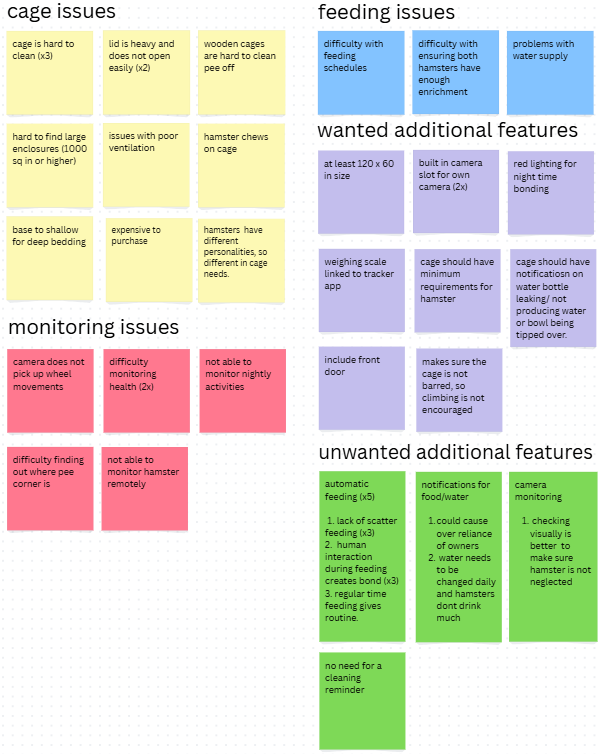
- interest in smart features:
- Automatic feeder with portion control: As can be seen in the survey responses, in the figure below, a majority of the survey responses are strongly against automatic feeders. Reasons that were given for not wanting automatic feeding are the lack of scatter feeding, less human interaction with the hamster and that regular feeding times give the hamster routine.
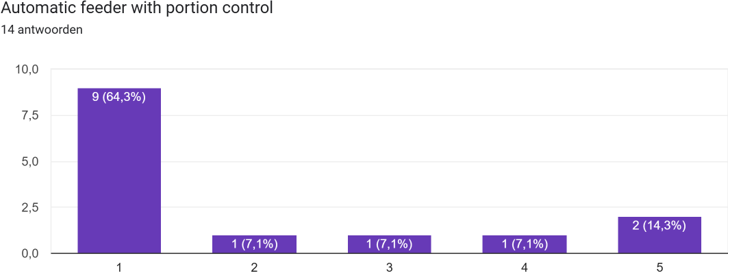
Automatic feeder with portion control survey result - App notifications for water/food low: as can be seen in the figure below the responses on the need for app notifications regarding food/water are divided. Criteria on this smart feature was that it could cause over reliance of owners and, that the water would need to be changed every day either way and the hamster does not drink much.
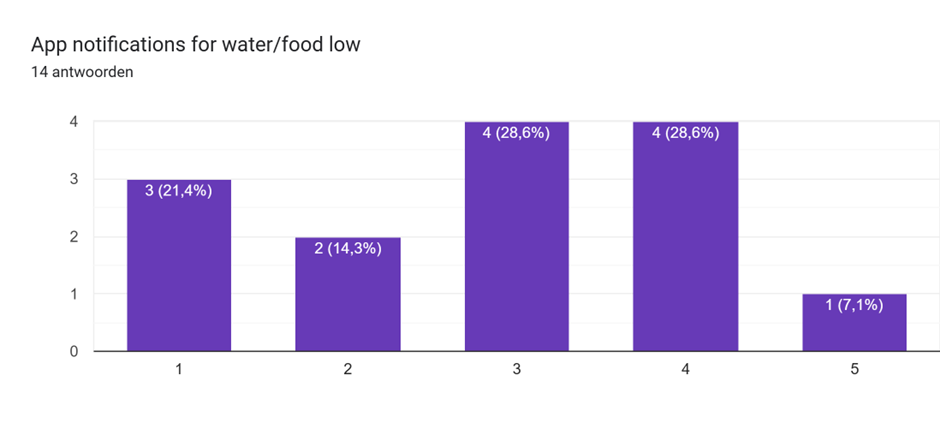
App notifications for water/food low survey results - Activity tracking (wheel distance, movement): As can be seen in the survey responses, in the figure below, a majority of the survey responses are in favor of activity tracking. One current activity tracking issues that was given is that one responders current camera does not pick up wheel movements. One criteria that was given on this feature is that it would be better to check the hamster visually so it does not get neglected.
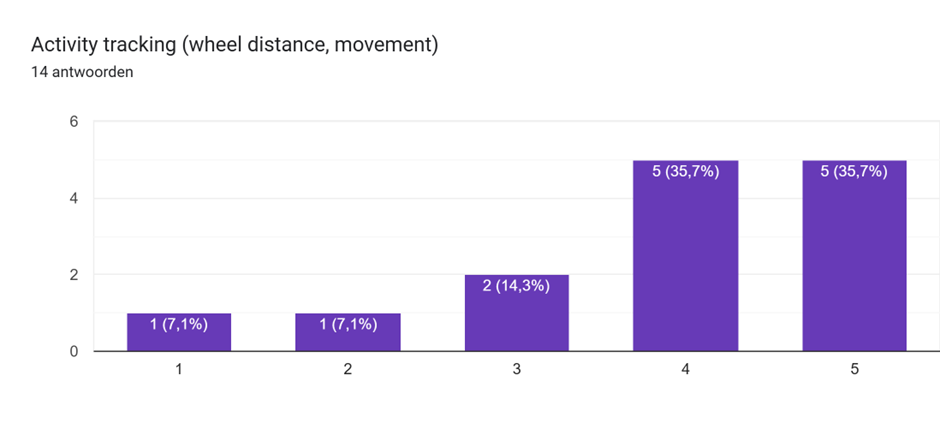
Activity tracking (wheel distance, movement) survey results - Temperature & humidity alerts: as can be seen in the figure below the responses on the need for app notifications regarding temperature are divided. However, no issues/criteria about this feature were stated in the responses to the survey.
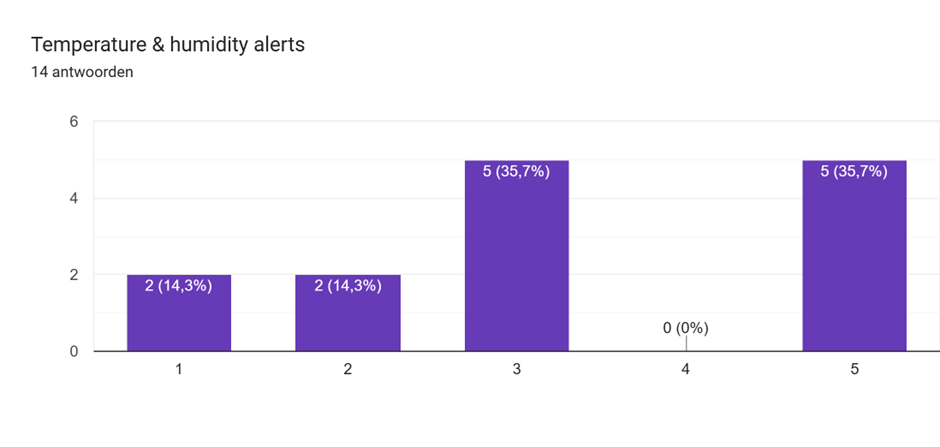
temperature & humidity alerts survey results - Camera for live monitoring: As can be seen in the survey responses, in the figure below, a majority of the survey responses are in favor of activity tracking, there are also no responses against this feature. Some current activity tracking issues that were given can be found in the affinity diagram figure under monitoring issues.
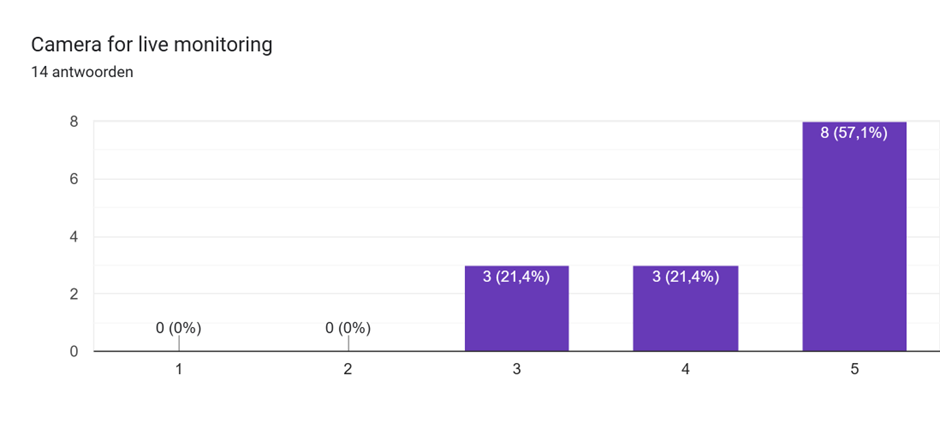
Camera for live monitoring survey results - Air-quality/ammonia sensor to suggest cleaning: as can be seen in the figure below the responses on the need for an air-quality/ ammonia sensor to suggest cleaning are divided. However, no issues/criteria about this feature were stated in the responses to the survey.
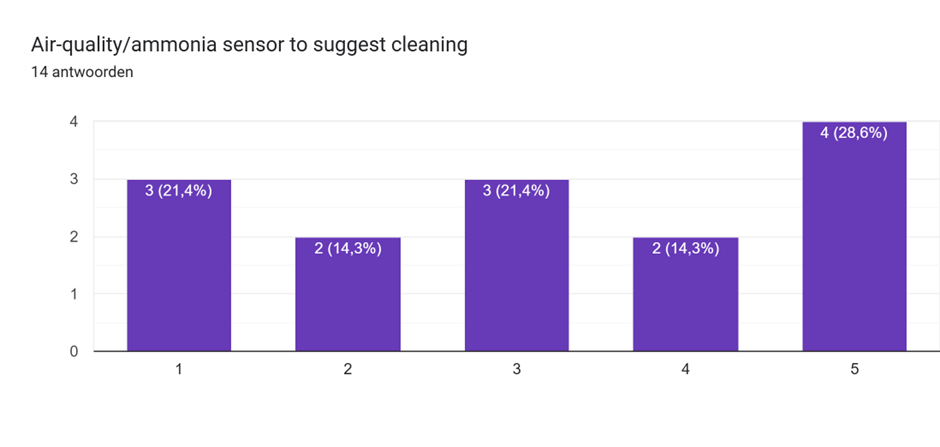
Air-quality/ammonia sensor to suggest cleaning survey results
User info:
- age range:
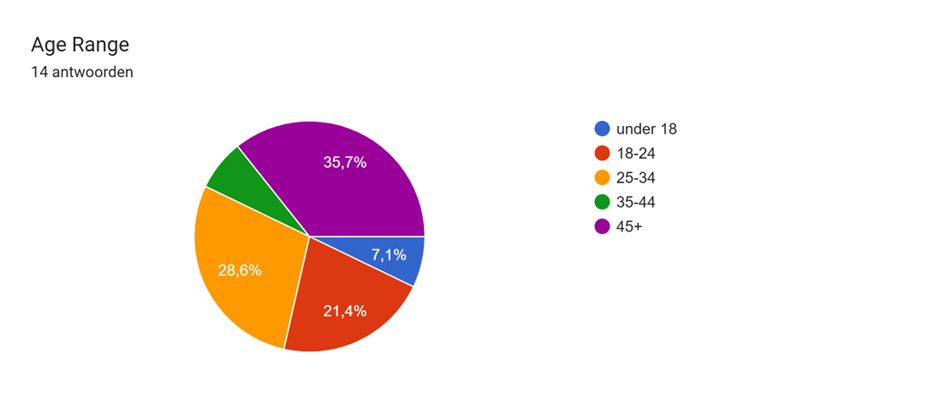
age range survey results - country/region:
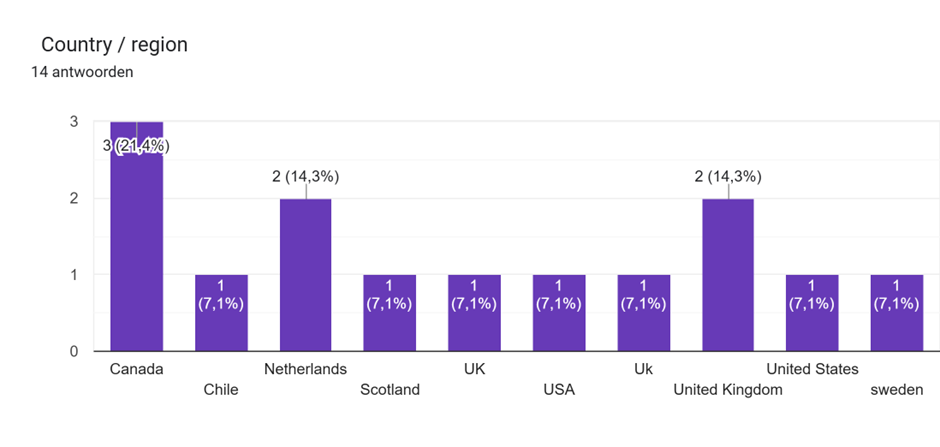
country/region survey results - household type:
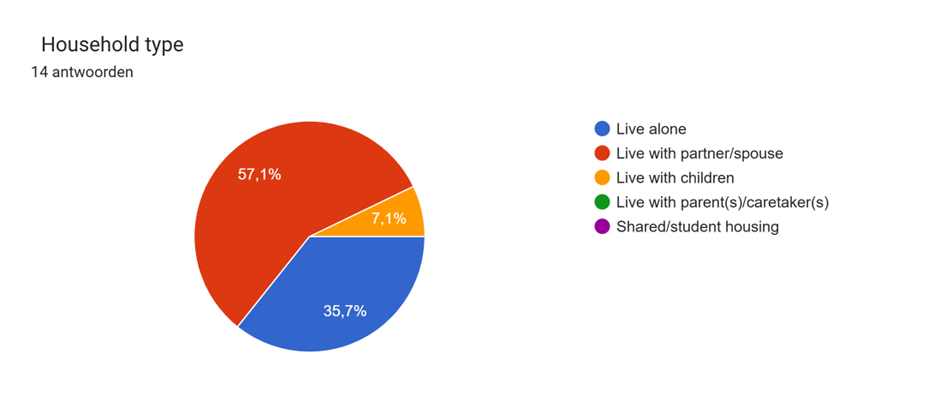
household type survey results - approximate household income range:
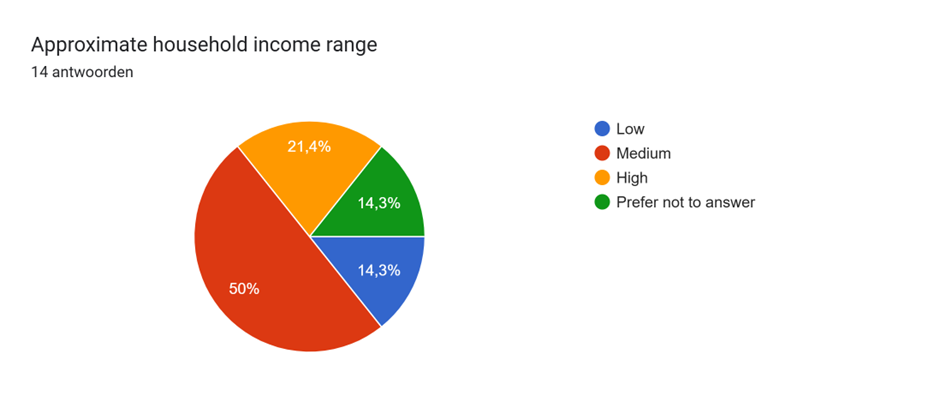
Approximate household income range survey results
hamster experience:
- How many hamsters do you currently own?:
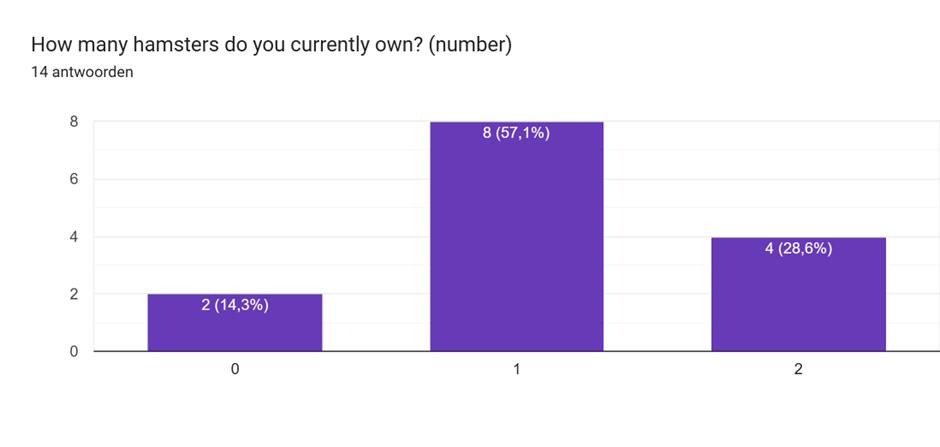
How many hamsters do you currently own? survey results - How long have you kept hamsters?:
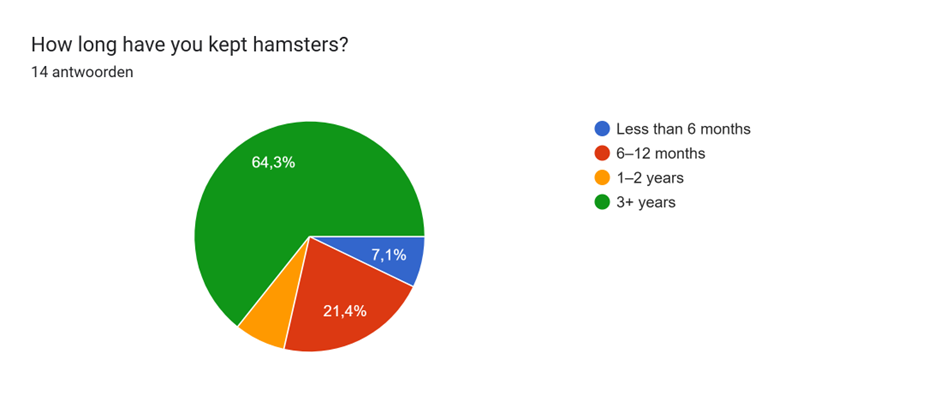
How long have you kept hamsters? survey results - Species/breed of hamster(s):
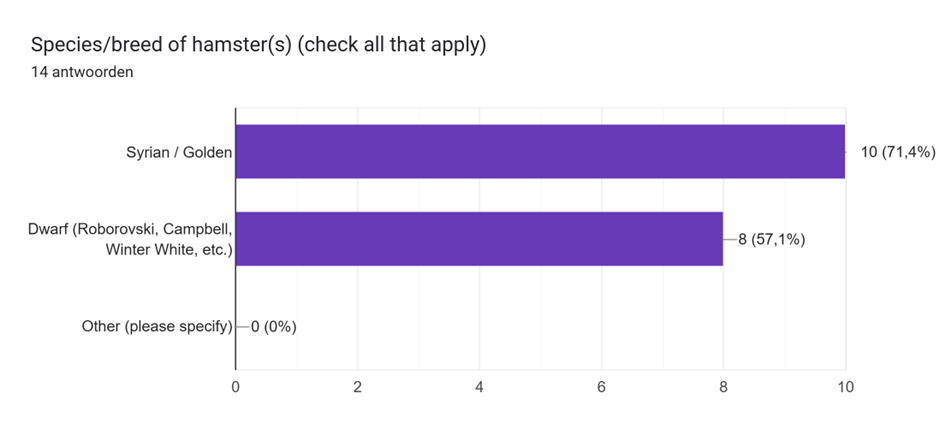
Species/breed of hamster(s) survey results
current products and pain points:
- current products: The items that were responded under other were the bucatstate 3.0(2x) and a custom made wooden enclosure with glass front(1x).
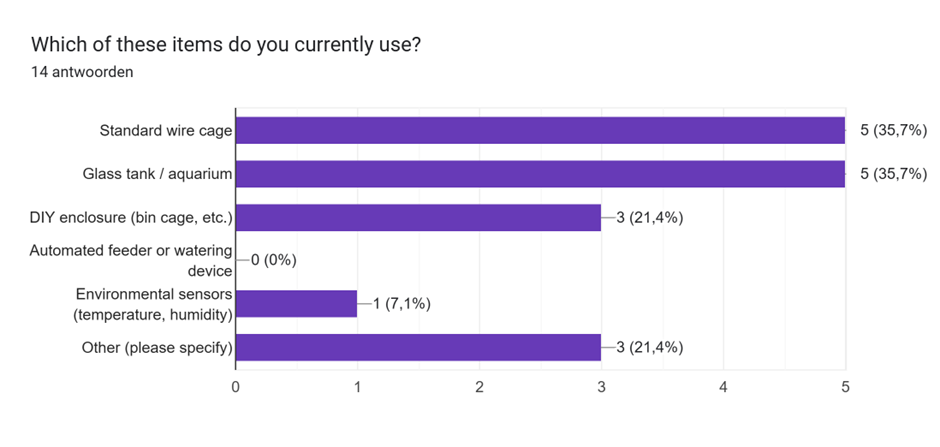
Which of these items do you currently use? survey results - How do you currently monitor your hamster’s health or activity?: The methods that were responded under other were feeling for lumps(2x), cameras(2x) and holding and watching the hamster.
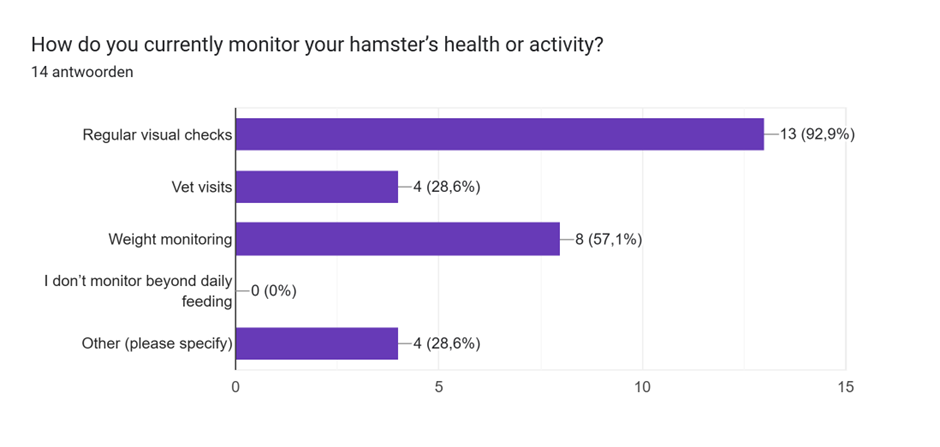
How do you currently monitor your hamster’s health or activity? survey results
Appendix
Interview Transcripts
Hamster Homeowners: Interview 1 -
Hamster Homeowners: Interview 2 -
Hamster Researchers: Interview 1 -
Hamster Researchers: Interview 2 -
Hamster Veterinarians: Interview 1 -
Hamster Veterinarians: Interview 2 -
Task Division
| Name | Study | Task Focus |
|---|---|---|
| Robert Arnhold | Mechanical Engineering | Mechanical design and prototyping |
| Sietse Bosman | Applied Physics | Simulation & modeling of parts and prototype |
| Octavian Astefanei | Electrical Engineering | Electrical design and assembly of electrical parts/features |
| Anne Willems | Electrical Engineering | Electrical design and assembly of electrical parts/features |
| Kerim Gjergjizi | Electrical Engineering | Electrical design and assembly of electrical parts/features |
| Lucas Spronk | Computer Science | Programming of digital part systems, companion software |
Bibliography
- [1] Packaged Facts. (2019, February 13). Baby boomers and millennials are redefining modern pet ownership trends, reports Packaged Facts. Business Insider. https://markets.businessinsider.com/news/stocks/baby-boomers-and-millennials-are-redefining-modern-pet-ownership-trends-reports-packaged-facts-1028733944
- [2] Zoonerdy. (2022, October 19). What is the number of hamsters in the United States? Zoonerdy. https://zoonerdy.com/what-is-the-number-of-hamsters-in-the-united-states
- [3] PR Newswire. (2013, February 12). Pet population and pet owner trends in the U.S.: Fish, birds, reptiles, and small animals. PR Newswire. https://www.prnewswire.com/news-releases/pet-population-and-pet-owner-trends-in-the-us-fish-birds-reptiles-and-small-animals-191262301.html
- [4] Petfood Industry. (2022, July 27). Survey examines U.S. pet ownership demographics. Petfood Industry. https://www.petfoodindustry.com/pet-food-market/article/15464848/survey-examines-us-pet-ownership-demographics
- [5] P Market Research. (2023). Household small animal treats market. P Market Research. https://pmarketresearch.com/hc/household-small-animal-treats-market/
- [6] T. Shibanoki, Y. Yamazaki, H. Tonooka (2024). A System for Monitoring Animals Based on Behavioral Information and Internal State Information. Animals. https://www.mdpi.com/2076-2615/14/2/281
- [7] Askew, A., González, F. (2014) A low-cost automated apparatus for investigating the effects of social defeat in Syrian hamsters. Behav Res 46, 1013–1022 . https://doi.org/10.3758/s13428-013-0427-x
- [8] E. Godynyuk, M.N. Bluitt, J.R. Tooley, A.V. Kravitz, M.C. Creed (2019) An Open-Source, Automated Home-Cage Sipper Device for Monitoring Liquid Ingestive Behavior in Rodents https://pmc.ncbi.nlm.nih.gov/articles/PMC678734
- [9] O.E. Castillo-Arceo, R.U. Renteira-Flores, P.C. Santana-Mancilla (2024) Design and Development of a Smart Pet Feeder with IoT and Deep Learning https://www.mdpi.com/2673-4591/82/1/63
- [10] T.W. Tilston, R.D. Brown, M.J. Wateridge, B. Arms-Williams, J.J. Walker, Y. Sun, T. Wells (2019) A Novel Automated System Yields Reproducible Temporal Feeding Patterns in Laboratory Rodents. Elsevier. https://www.sciencedirect.com/science/article/pii/S0022316622167295?via%3Dihub
- [11] J. Benedict, R.H. Cudmore (2023) PiE: an open-source pipeline for home cage behavioral analysis. Neurosci https://www.frontiersin.org/journals/neuroscience/articles/10.3389/fnins.2023.1222644/full
- [12] M. Saeedi, A. Maddahi, A.M. Nassiri, M. K. Zareina (2022) CageView: A Smart Food Control and Monitoring System for Phenotypical Research In Vivo. applied sciences. https://www.mdpi.com//2076-3417/12/10/4966
- [13] K.P. Nguyen, M.A. Ali, T.J. O'Neal, I. Szczot, J.A. Licholai, A.V. Kravitz (2017) Feeding Experimentation Device (FED): Construction and Validation of an Open-source Device for Measuring Food Intake in Rodents. J Vis Exp. https://pmc.ncbi.nlm.nih.govarticles/PMC5409291//
- [14] J. Oh, R. Hofer, W.T. Fitch (2016) An open source automatic feeder for animal experiments. HardwareX.https://www.researchgate.net/publication/309307810_An_open_source_automatic_feeder_for_animal_experiments
- [15] A. Mingrone, A. Kaffman, A. Kaffman (2020) The Promise of Automated Home-Cage Monitoring in Improving Translational Utility of Psychiatric Research in Rodents. frontiers in neuroscience. https://pmc.ncbi.nlm.nih.gov/articles/PMC7773806/
- [16] Truong, V. H., & Myung, J. (2023). LocoBox: Modular Hardware and Open-Source Software for Circadian Entrainment and Behavioral Monitoring in Home Cages. Sensors, 23(23), 9469–9469. https://doi.org/10.3390/s23239469
- [17] Moore, J. L., Kennedy, J., & Hassan, A.-A. (2024). Automated home cage monitoring of an aging colony of mice—Implications for welfare monitoring and experimentation. Frontiers in Neuroscience, 18. https://doi.org/10.3389/fnins.2024.1489308
- [18] Xie, X. S., Zhang, J., Zou, B., Xie, J., Fang, J., Zaveri, N. T., & Khroyan, T. V. (2012). Rodent Behavioral Assessment in the Home Cage Using the SmartCageTM System. Springer Protocols Handbooks/Springer Protocols, 205–222. https://doi.org/10.1007/978-1-61779-576-3_13
- [19] Taro Shibanoki, Yamazaki, Y., & Hideyuki Tonooka. (2024). A System for Monitoring Animals Based on Behavioral Information and Internal State Information. Animals, 14(2), 281–281. https://doi.org/10.3390/ani14020281
- [20] Mingrone, A., Kaffman, A., & Kaffman, A. (2020). The Promise of Automated Home-Cage Monitoring in Improving Translational Utility of Psychiatric Research in Rodents. Frontiers in Neuroscience, 14. https://doi.org/10.3389/fnins.2020.618593
- [21] L. Robinson, G. Riedel (2014) Comparison of automated home-cage monitoring systems: Emphasis on feeding behaviour, activity and spatial learning following pharmacological interventions. Journal of neuroscience methods. https://www.sciencedirect.com/science/article/pii/S0165027014002258?via=ihub
- [22] M.C. Melo, P.E. Alves, M.N. Cecyn, P.M.C. Eduardo, K.P. Abrahao (2022) Development of Eight Wireless Automated Cages System with Two Lickometers Each for Rodents. eNeuro. https://pmc.ncbi.nlm.nih.gov/articles/PMC9355285/
- [23] Virag, D., Homolak, J., Kodvanj, I., Virag, A.-M., Perhoč, A. B., Patrik Meglić, Mužić, P. Š., Knezović, A., Jelena Osmanović Barilar, Cifrek, M., Vladimir Trkulja, & Šalković-Petrišić, M. (2025). My friend MIROSLAV: A hackable open-source hardware and software platform for high-throughput monitoring of rodent activity in the home cage. Behavior Research Methods, 57(7). https://doi.org/10.3758/s13428-025-02719-x
- [24] Fenton, L., Benato, L., Mancinelli, E., & Rooney, N. J. (2025). What are the Most Prevalent Welfare Issues for Pet Small Mammals? Animals, 15(10), 1423. https://doi.org/10.3390/ani15101423
- [25] Nederlandse Voedsel- en Warenautoriteit. (2023). Zo doende 2023. In Jaaroverzicht Dierproeven en Proefdieren. https://www.nvwa.nl/onderwerpen/dierproeven-voor-onderzoek/documenten/dier/dierenwelzijn/zo-doende/publicaties/zo-doende-2023-jaaroverzicht
Weekly Tasks
Week 1
| Name | Total Time Spent [hours] | Task Breakdown |
|---|---|---|
| Robert Arnhold | 7 | Three weekly meetings (1h each), Plan sections (4h, Concept Introduction, Objectives, Users) |
| Sietse Bosman | 5 | Two weekly meetings (1h each), Deliverables (3h) |
| Octavian Astefanei | 7 | Three weekly meetings (1h each), Planning, Milestones (2h), Research on existing technology (2h) |
| Anne Willems | 14 | Two weekly meetings (1h each), part of SoTa (12h, read and summarized articles: [6],[7],[8],[9],[10],[11],[12],[13],[14],[15],[23],[24]) |
| Kerim Gjergjizi | 6 | One weekly meetings (1h), Approach (2h), Research and Finding potential features (3h) |
| Lucas Spronk | 9 | Three weekly meetings (1h each), other part of SotA (8h) |
Week 2
| Name | Total Time Spent [hours] | Task Breakdown |
|---|---|---|
| Robert Arnhold | 7 | Three weekly meetings (1h each), writing interview questions (3h), contacting potential interview participants (2h) |
| Sietse Bosman | 6 | Three weekly meetings (1h each), Research and contacting animal testing facilities (3h) |
| Octavian Astefanei | 7 | Three weekly meetings (1h each), Research for veterinarian clinics (1h), Writing interview questions (2h), Contacting veterinarian clinics (1h) |
| Anne Willems | 6 | Three weekly meetings (1h each), writing survey questions and looking for forums to post survey on (3h) |
| Kerim Gjergjizi | 5 | Two weekly meetings (1h each), Survey Questions and Making the Survey (3h) |
| Lucas Spronk | 5 | Three weekly meetings (1h each), research for ethical approval and implementation into survey/interview (2h) |
Week 3
| Name | Total Time Spent [hours] | Task Breakdown |
|---|---|---|
| Robert Arnhold | 8 | Two weekly meetings (1h each), conducting interviews with hamster owners (1.5h each), transcribing recordings (2h each) |
| Sietse Bosman | ||
| Octavian Astefanei | ||
| Anne Willems | 6 | Two weekly meetings (1h each), looking into data processing methods(1h), assessing survey results and making affinity diagram (3h) |
| Kerim Gjergjizi | ||
| Lucas Spronk |